Regina’s Advisory Program Continues to Develop
Photo Credit/ Photo Credit/Yearbook Staff
Regina Advisory at the beginning of the school year.
The discussion regarding the advisory program and its importance within the school curriculum has been at the forefront of Regina Dominican’s mind for the past several years.
During the 2019-2020 school year, a major change was made. Advisory—a once brief, morning interval— became an established 30 minute period to provide a sense of community and “home base” to the students at the school.
According to the Advisory Committee, the purpose of the advisory program is “to build healthy and happy individuals, put adolescents on a path to become fully actualized adults, help students reflect on their learning as a whole, not just one particular course, and establish and convey school values, norms, and positive culture.”
The school recognized a need for improvement in the functionality of the student body’s schedule and community and made a change. Now, three years later, the school community is still debating whether the current structure of the advisory program is well-suited for the students at the school or if it’s time for an adjustment of the program’s design.
When asked about their general opinions on the advisory program and the way it is utilized during the school day, senior Margaret Clancy stated, “I think that it is a waste of time, but it does, however, count for instructional time so I would not want to replace it with class time. I think it is just something that we have got to get through, but I do not like that it is so restricted.”
Other students said that they enjoyed and utilized the current atmosphere created due to advisory and its design. “I really like the sense of community it creates,” said Kathy Marzec ’23
A common misconception about advisory is that it is useless and insignificant to the culture and environment within a school like Regina Dominican. The bottom line is that advisory is truly a necessary part of the school day. It is part of the Illinois high school required instructional time of 300 minutes (5 hours), a stipulation that Regina Dominican and other high schools across the state must legally follow.
Dr. Porreca explained the instruction time further: “For us to be credited by the state, we have to have a schedule that includes at least 300 minutes of instructional time a day, on average.”
Dr. Porreca also added. “Instructional time” is considered to be anything that is educational. That being said, passing periods, lunch, and morning meetings are not part of those minutes. In terms of the advisory program, “because we have a curriculum for advisory and because of all the different activities that take place in it that are educational, it counts as instructional time.”
As a small, community-based high school, advisory is important to both “the mission of the school” as well as the goals that the school sets for its students. As explained by Dr. Porreca, “one of our big goals was to strengthen academic time so our students are more and more prepared for college, that our academics remain challenging, and that [we are] still having a space in the day where we can do fun things or things that are not directly related to the curriculum of a particular class but that strengthen your academic support system.”
The real question is not whether advisory is “necessary” but rather, how should the time be utilized?
A survey was distributed, asking a random sample of students—approximately 20 per grade level—about their opinions regarding the advisory program. Students were surveyed anonymously, however, their grade levels were recorded. As pictured below, each pie chart demonstrates for those who answered “yes”, how much of that total number is held by each grade level. The bar graphs offer a more in depth representation of the number of students—separated by grade level—that answered “yes” and the number of students that answered “no”.
When asked if they are satisfied with the current design of the advisory program, 37% of the sample answered yes, with the majority of that number being from the freshmen of the sample. In contrast, only 16.7% of those satisfied were upperclassmen.
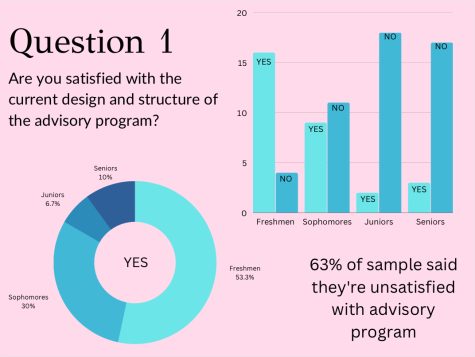
For the second question, students were asked about academic disruptions due to the advisory program. 79% of the student sample answered “yes”. To compare, 65% (26/40) of the underclassmen said they had experienced substantial academic disruptions, while 93% (37/40) of the upperclassmen answered “yes”, as well.
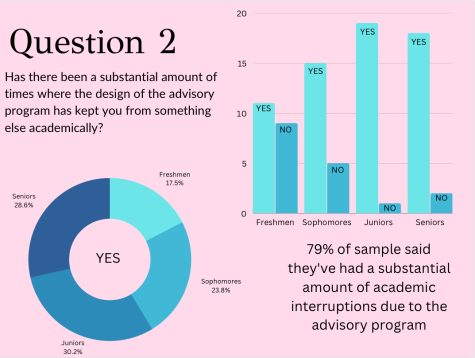
In the third question, students were asked if the advisory program fulfills its purpose of building relationships, community, and academic success. Of the total sample, 40% said they found the current design of the program to be beneficial and 53.1% of those who answered “yes” were freshmen. To compare, 85% (17/20) of the Freshmen students answered “ yes” while only 35% (7/20) of the Sophomore students answered “yes” and as the grade levels increased, so did the number of “yes” answers. This indicates that somewhere between one’s Freshmen and Sophomore year, the true purpose of advisory becomes mistranslated and therefore, its effectiveness decreases.
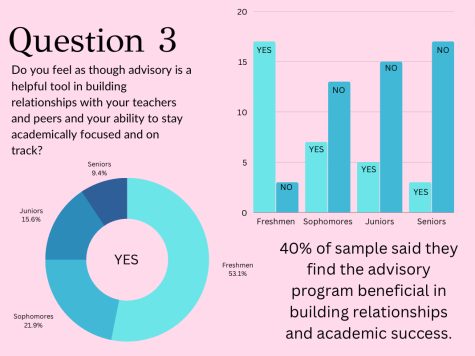
For the final question, a suggestion for a potential adjusting of the advisory program was asked. A resounding 91% of the sample said they would prefer that advisory be more based around the structure of study hall—with respect to the purpose and intent behind the curriculum within advisory. 85% (34/40) of the underclassmen answered “yes” while 98% (39/40) of the upperclassmen answered “yes”.
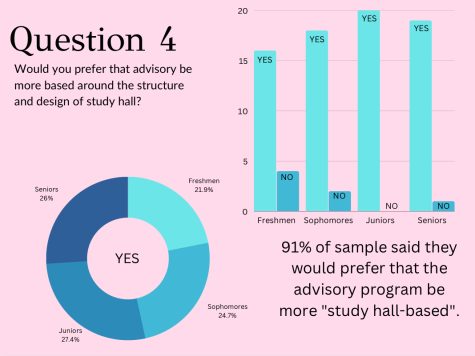
The suggestion for the advisory program to become a “study hall” is among one of several proposals for a potential revision of the current design of the program. Mrs. Herrington, a member of the advisory committee, explained one of her hopes for the future of the program, “Ultimately, I would love to see a different advisory curriculum for every grade level. So, freshmen focus on something different from sophomores, different from juniors and seniors.”
As the survey results show, for freshmen and sophomores, building a strong foundation of community and relationships with their peers and teachers is crucial, whereas with juniors and seniors, preparation for life after high school is at the forefront of their minds. Courses in “financial literacy or public speaking or business or skill-building that all students need to be successful” are also components of Mrs. Herrington’s hopes for advisory.
When asked if the school is open to suggestions regarding the program, Dr. Porreca stated, “Yeah, in fact, Mrs. Allworth and I met with the student class leadership boards and student council and there were comments about that. One of the things that people suggested is that we should improve advisory time. And then we asked people to write an action plan.”
The school welcomes and appreciates student feedback as long as it aligns with the “vision and shared goals” of the advisory program.
When asked if she feels as though the vision of the advisory program has been fulfilled, Dr. Porreca answered “100% no. One of the things that we need to do is more education for students about what advisory is, why we have it, why it’s important, and how it fulfills the mission of the school.
As of today, the discussion regarding potential adjustments and alterations to the advisory program still lies on the table. One of the most unique aspects of a school like Regina Dominican is not only its ability to adapt and progress as time goes on but its willingness to truly listen and value the opinions and perspectives of its student body.
What is your view on the advisory program and it’s design? Share your comments below.
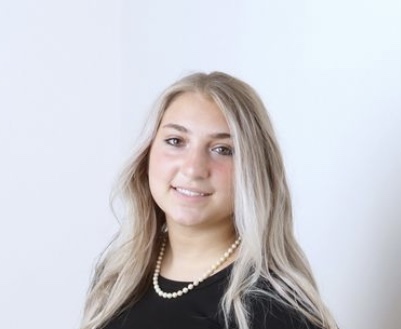
Ashlyn Foley is a senior at Regina Dominican High School where she serves as a staff reporter for Crown. She likes to write about the environment, space...


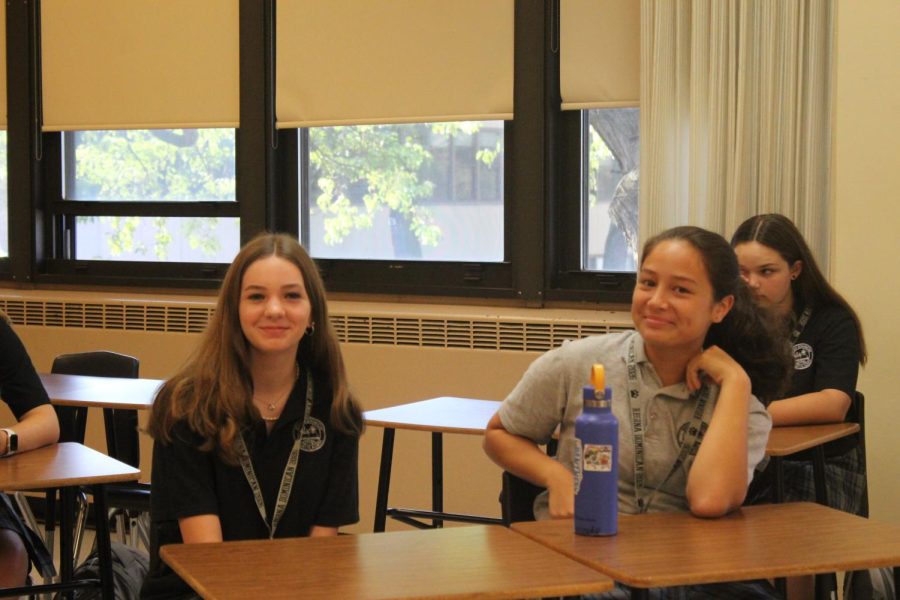
Katie Koenig • Jan 6, 2023 at 2:32 pm
This article opens my eyes to the true purpose of advisory and how it is important for Regina and its impacts to the Regina community
Maggy • Jan 6, 2023 at 2:30 pm
Amazing article, maybe this will give some teachers an awakening on how to benefit their advisory experience
Delilah Storball • Jan 6, 2023 at 2:29 pm
I liked seeing the data.
Kendall • Jan 6, 2023 at 2:28 pm
This is really great and it was a very engaging read!
Mrs. Van Treese • Dec 15, 2022 at 8:02 am
Ashlyn, thank you for your well-thought out article. The data you collected will be so helpful as Regina continues to develop its advisory program. Good work!
Ms. Tully • Dec 15, 2022 at 5:31 am
Great article Ashlyn! Well written, with strong support and so much to consider!